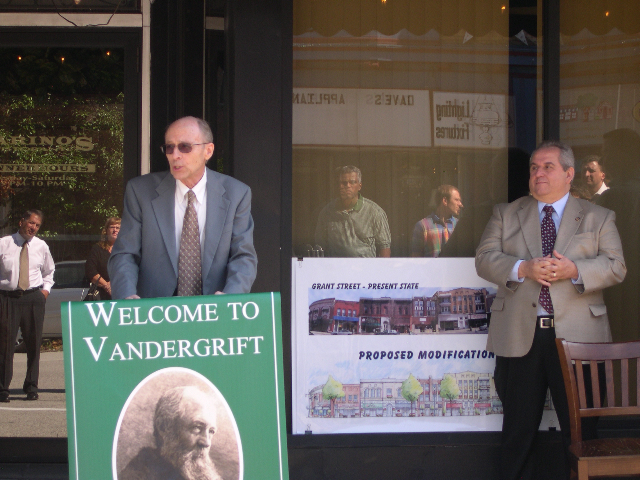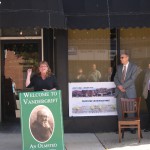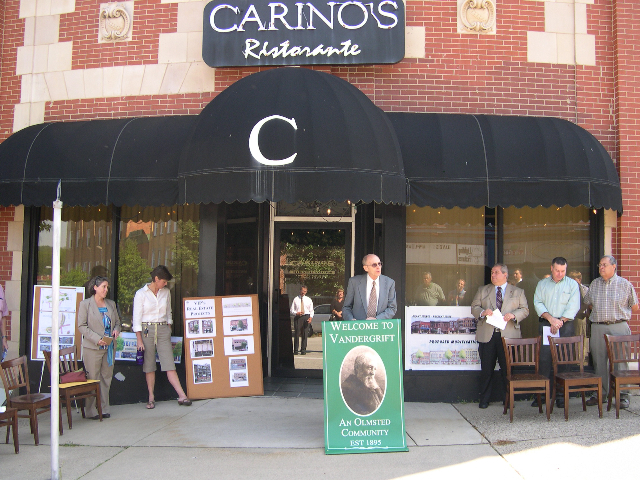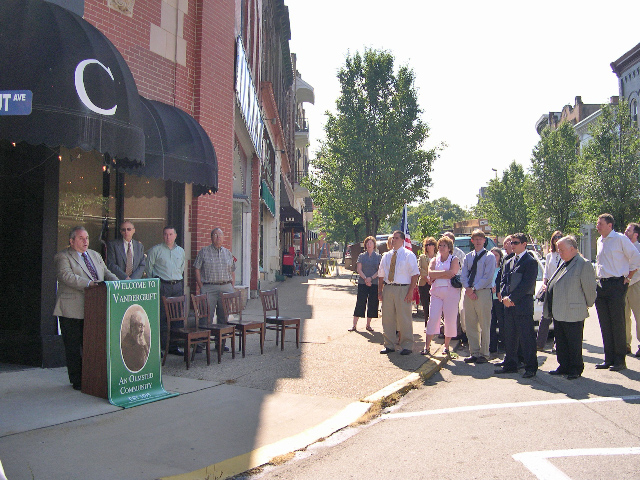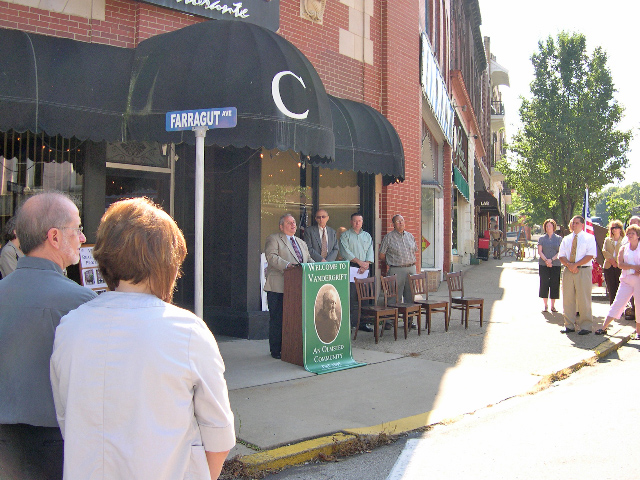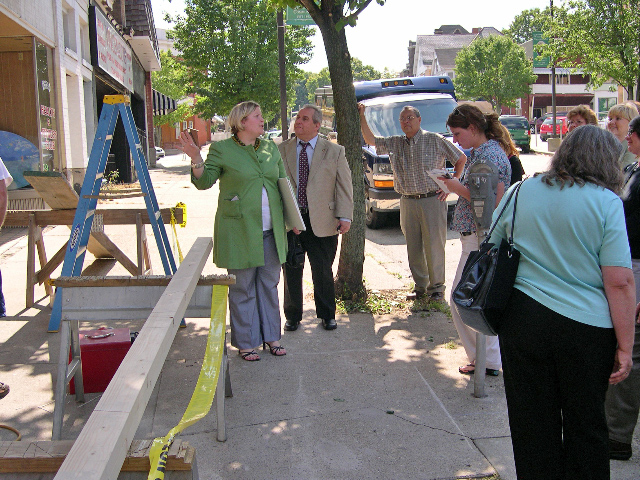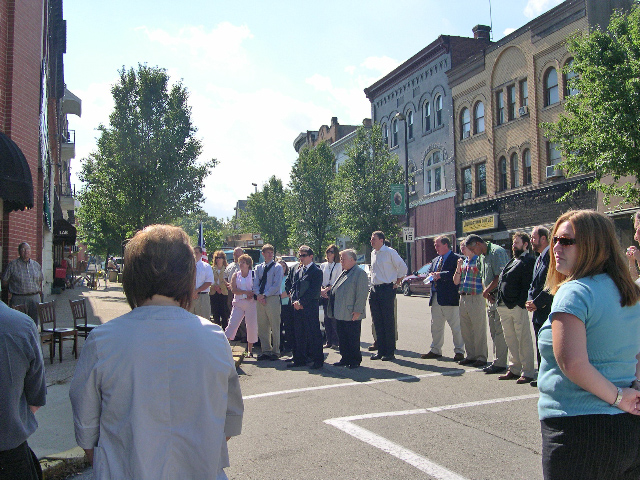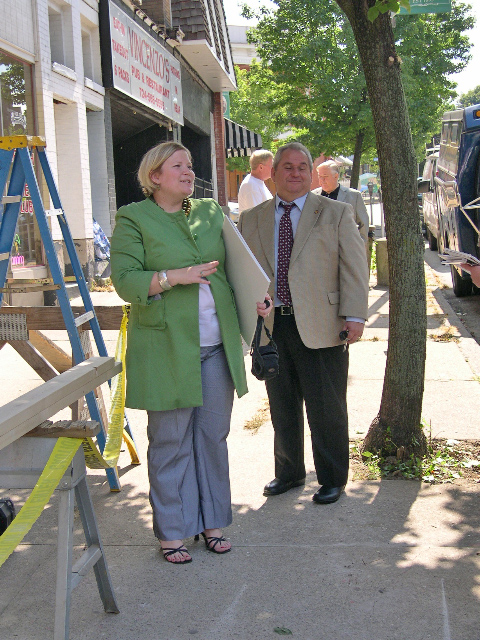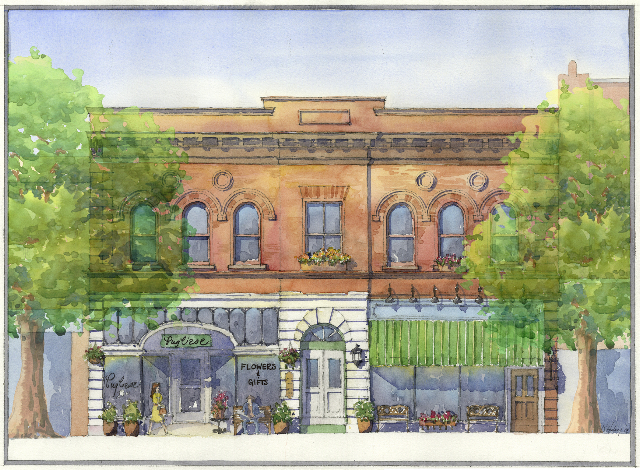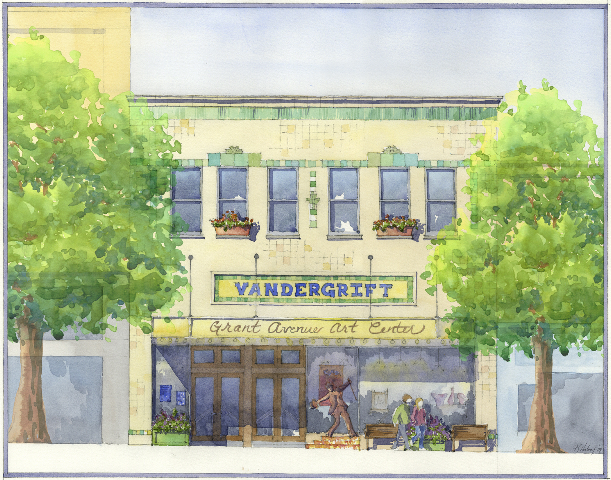
Category Archive: Preservation News
-
Public Hearing on 200-210 Fifth Ave, and 438 & 440 Market Street
PREPARED TESTIMONY OF
ANNE E. NELSON, ESQ.
GENERAL COUNSEL
PITTSBURGH HISTORY & LANDMARKS FOUNDATION
BEFORE HISTORIC REVIEW COMMISSION, CITY OF PITTSBURGH
PUBLIC HEARING ON 200-210 FIFTH AVENUE; 438 & 440 MARKET STREET
NOVEMER 5, 2008
As the future holder of a preservation easement on the Buhl Building and current holder of design control rights on the adjacent properties, Landmarks supports N&P Properties’ plans to rehabilitate the exterior of the Buhl Building, demolish the adjacent structures, and build a new building adjacent to the Buhl. The size, scale, and color of the proposed adjacent building compliment the blue terra cotta Buhl Building. Landmarks’ support of N & P Properties’ plans for the Buhl Building and adjacent structures, however, is contingent on the Pennsylvania Historical and Museum Commission approving Part 2 of their Federal Rehabilitation Tax Credit application.
-
Public Hearing at Historic Review Commission on 200-210 Fifth Avenue, and 438 & 440 Market Street
PREPARED TESTIMONY OFANNE E. NELSON, ESQ.
GENERAL COUNSEL
PITTSBURGH HISTORY & LANDMARKS FOUNDATION
BEFORE HISTORIC REVIEW COMMISSION, CITY OF PITTSBURGH
PUBLIC HEARING ON 200-210 FIFTH AVENUE; 438 & 440 MARKET STREET
NOVEMER 5, 2008
As the future holder of a preservation easement on the Buhl Building and current holder of design control rights on the adjacent properties, Landmarks supports N&P Properties’ plans to rehabilitate the exterior of the Buhl Building, demolish the adjacent structures, and build a new building adjacent to the Buhl. The size, scale, and color of the proposed adjacent building compliment the blue terra cotta Buhl Building. Landmarks’ support of N & P Properties’ plans for the Buhl Building and adjacent structures, however, is contingent on the Pennsylvania Historical and Museum Commission approving Part 2 of their Federal Rehabilitation Tax Credit application.
-
Public Hearing Before Historic Review Commission on 4420 Bayard Street
PREPARED TESTIMONY OF
ANNE E. NELSON, ESQ.
GENERAL COUNSEL
PITTSBURGH HISTORY & LANDMARKS FOUNDATION
BEFORE HISTORIC REVIEW COMMISSION, CITY OF PITTSBURGH
PUBLIC HEARING ON 4420 BAYARD STREET, THE ELMHURST GROUP
OCTOBER 1, 2008
Pittsburgh History & Landmarks Foundation has reviewed the Elmhurst Group’s plans for a new office building in the parking lot behind and owned by the First Baptist Church in Oakland. We appreciate the very good efforts of the Elmhurst Group in regard to the planning and redesign of the structure. In particular, the building’s height, materials, and setback on Bayard Street are in accordance with the other buildings on the street and harmonize the building with the Church. The higher portion of the building along Ruskin Avenue complements the Ruskin Apartment and its materials and to some degree its style.
However, we have the following concerns with the building:
1. The top portion of the seven-story building should be redesigned without the projecting central overhang, which is something of a cliché in modern design. We also suggest that the stringcourse be continued across the Bayard/Bigelow façade just as it does on the Ruskin Avenue façade and with the elongated windows eliminated. We believe that such detailing is inappropriate next to the architecturally-significant First Baptist Church, the Ruskin Apartment Building and the houses of Schenley Farms.
2. We recommend that the walkway around the building be planted with sycamore trees instead of columnar trees as shown. We would be happy to meet with the City Forester to discuss the matter of tree selection. A few columnar trees were planted years ago further west on Bayard Street and they are still nothing more than elongated toothpicks with a few leaves attached. Sycamore trees, used throughout Schenley Farms, arch up over the streets and provide a canopy of elegance, beauty, and shade.
We continue also to have a significant concern with the Historic Review Commission’s jurisdiction and ability to review new construction in historic districts. We hope this matter can be resolved or clarified so as not to cause issues with other new construction projects in historic districts.
-
Vandergrift Main Street Gets Lift
by Shaun Yurcaba
Pittsburgh History & Landmarks Foundation
September 8, 2008Sen. Jim Ferlo announced today a $35,000 grant to assist the Vandergrift Main Street program. This grant will be added to the Restoration Revolving Fund, which was created in 2006 to bring new life to downtown Vandergrift and to restore its distinctive buildings. The Revolving Fund was initially capitalized with a $300,000 grant from the Allegheny Foundation, a charitable entity of Richard M. Scaife.
In addition, the Vandergrift Improvement Program (VIP), Inc., a non-profit organization, announced the acquisition of two new buildings in the heart of downtown Vandergrift, and the restoration of a third building, all utilizing the original Scaife grant to establish the Revolving Fund.
“The VIP is using the Restoration Revolving Fund so effectively that I am very pleased to add additional state resources to it for further leverage,” said Sen. Ferlo.
143 Grant Ave: The VIP purchased 143 Grant Ave. in 2007 and has completed a complete masonry and storefront restoration of the facade. The roof has been replaced. The VIP is in negotiations with a tenant who plans to open a bakery and yoga studio on the first floor and live above in the second floor residential unit.
139/141 Grant Ave: The VIP has just secured 139-141 Grant Avenue. The roof, which had been severely compromised, has already been replaced. The VIP is also upgrading the electrical system and plans to fully restore the facade. Long term plans include renovating the 5 second floor apartments, which are uninhabitable.
134 Grant Ave: The VIP also just secured 134 Grant Avenue (the former JC Penny’s Building). The VIP has cleared the building of debris and is working on a long term plan to locate a Community Art Center and a small business incubator in this space.
According to Meade Jack, President of the VIP, downtown Vandergrift has reached a tipping point. “We have invested a lot of time and hard work in this effort. But it’s been well worth it. The seeds we’ve planted the last several years are now starting to bear fruit. We have a long way to go but we are on the right track,” Jack said. “We are demonstrating that there is still plenty of life in Pennsylvania’s small towns.”
The VIP began in 2003 with a grant from Sen. Ferlo and received DCED Main Street designation in 2006. The main street program is in year three and is being managed in partnership with the Pittsburgh History and Landmarks Foundation (PHLF).
- Arthur P. Ziegler, Jr.
- Shaun Yurcaba and Senator Jim Ferlo
- Vandergrift Flower Shop Rendering
- Vandergrift Art Center Rendering
-
Dr. Howard Slaughter, Jr. Discusses Urban Economic Loan Fund
Howard Slaughter Jr., CEO of Landmarks Community Capital Corporation interviewed on KDKA’s “The Sunday Business Page” and discusses the Urban Economic Fund at the Homewood branch of PNC Bank.
Press Play to View Video
-
Owner of Lamp Theater in Irwin says restoration depends on funding
Thursday, August 07, 2008Pittsburgh Post-GazetteThe Lamp Theater closed more than three years ago.
Two different owners have since given projections of when the landmark showplace on Main Street in Irwin would reopen.
A small, hand-painted sign on the marquee confidently proclaims: “The Lamp will shine brightly again!”
But folks and borough officials are wondering: When?
Their concern is justified. A revival of the 73-year-old former movie theater could be a key to the 144-year town’s future.
Nearly $400,000 in emergency repairs were made, including replacement of a collapsed roof, extensive interior rehabilitation, disposal of mounds of debris and removal of 387 rain-damaged seats. Then the restoration stopped.
A glimmer of hope returned last month when contractors began installing a new plumbing system and upgrading electrical wiring to comply with national and borough codes.
“Restoration will continue as long as funding holds out,” said Bill Chapman, a partner in Irwin-based Koury, Chapman & Sinclair Real Estate Services. George Koury and Dave Sinclair are the other partners, who bought the theater in February 2005.
“The Lamp is woven into the fabric of the Norwin community,” Mr. Chapman added. “Every time workers appear and doors are open, folks and kids walking by stop to watch. They’re hoping the theater finally will reopen.”
In a complex deal in May 2006, the nonprofit Westmoreland Cultural Trust acquired the title to the theater from the real estate company in exchange for exclusive management rights. No purchase price was ever disclosed. Koury, Chapman & Sinclair agreed to continue its mortgage obligation with Irwin Bank.
Under the agreement, the trust, which operates the Palace Theater in Greensburg, will handle stage bookings and associated event promotion for the Palace and the Lamp. Movies also are planned for the Lamp.
“Actually, KCS donated the Lamp Theater to the trust for $1 because it is vital to the revitalization project,” Mr. Chapman clarified. “It’s easier for the trust to secure community development grants than a private business.
“Most people, including potential investors, who promised to help with funding have disappeared. Commercial money is tight these days. All we can do is hope things will work out.
“Considering the country’s fiscal crisis, nobody can realistically set a timetable for the Lamp to reopen. But, if we can get the right funding to finish most of the restoration, I’m optimistic the Lamp could reopen by late fall.”
Trust Executive Director Michael Langer, who predicted in 2006 that the Lamp would reopen in early 2007, did not return telephone calls seeking comment about the project.
On June 6, IBT Bancorp Inc., the parent company of Irwin Bank, merged with S&T Bancorp Inc., based in Indiana, Pa.
“S&T Bank intends to honor Irwin Bank’s commitments to the Irwin Project and community development in the Norwin Area,” said Charles Urtin, former IBT chief executive officer and now vice chairman of the S&T board of directors.
“S&T Bank will continue to be sensitive to efforts encouraging economic development in the Norwin community and surrounding areas.”
Three years ago, IBT made a commitment to donate $50,000 — in $10,000 increments over five years — to help develop a public-private partnership with the borough for the Irwin Project. That will be honored, said Mr. Urtin, an active member of the Irwin Project Steering Committee.
The Lamp became the anchor of the Irwin Project, an ambitious, long-term, economic revitalization of the business district, after the trust abandoned a planned $1.5 million to $2 million acquisition and renovation of the 119-year-old Thompson Building.
The objective is to turn the town into “Historic Irwin.”
Bob Michaud, a former IBT executive who initiated the revitalization effort nearly four years ago, once predicted the Lamp would be “a beacon” to draw people and investors to town.
“The Lamp Theater is essential to the revitalization of downtown Irwin, especially the business district,” said borough Councilwoman Danyce Neal.
“The theater has touched generations for seven decades.”
Norm Vargo is a freelance writer.First published on August 7, 2008 at 6:00 am -
Council grants North Side temple historic status
By Jeremy Boren
TRIBUNE-REVIEW
Wednesday, August 6, 2008Pittsburgh City Council Tuesday sought to end a long-simmering controversy by dubbing the former Malta Temple building in the North Side a historic structure.
The decision will protect the stately brick building on West North Avenue from demolition, but it also could prompt legal action from the Salvation Army, which has owned the former social club since the 1970s.
Salvation Army officials have fought the historic designation because they want to raze the edifice to make way for a larger $5 million facility on the same street. The nonprofit organization runs a social services center in the 81-year-old building, which officials say would be too costly to renovate.
Salvation Army officials last week said they might challenge City Council’s decision in court.
“We are very disappointed in the vote,” said Maj. Robert J. Reel, the organization’s Western Pennsylvania divisional commander. “And we are exploring our options.”
Members of the Mexican War Streets Society, a neighborhood group, said they nominated the Malta Temple building for historic status to preserve the neighborhood’s historic appeal.
In a final decision, City Council voted 8-1 in favor of the designation, with Councilman Ricky Burgess casting the lone dissenting vote.
Burgess argued historic designation should not be forced upon the building because it serves as a place of religious worship.
Jeremy Boren can be reached at jboren@tribweb.comor 412-765-2312.
-
Architect hopes to save former St. Mary’s in Lawrenceville
By Jenny Paul
TRIBUNE-REVIEW
Wednesday, August 6, 2008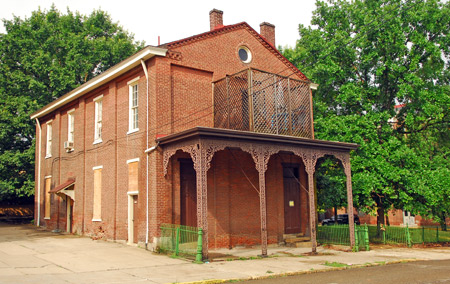
Pittsburgh’s Historic Review Commission will decide today whether a Lawrenceville structure slated for demolition should be recommended for designation as a local historic landmark.
The former St. Mary’s Academy was built in the Greek Revival style in 1854 and used as a church and school in the 19th century, according to Lawrenceville architect Keith Cochran, who nominated the building for historic landmark status to prevent its demolition.
Directors of the Catholic Cemeteries Association, which purchased the building and land from Our Lady of the Angels parish in 2005, want to tear down the building to create open land that eventually will be used for burial space as part of St. Mary Cemetery, Executive Director Annabelle McGannon said.
“It’s in a state of disrepair,” she said. “We have no use for the property, for the building. A cemetery’s treasure is in its land, not its building.”
If the commission decides the structure is a historic landmark, the nomination will advance to the city’s Planning Commission and to City Council for a final vote. Once designated as a local landmark, a building cannot undergo exterior changes, including demolition, without the city’s approval.
Cochran said the building should be preserved because it’s one of the few of its style in the city. The Pittsburgh History & Landmarks Foundation, the Lawrenceville Historical Society and the Lawrenceville Stakeholders support his bid, he said.
“It’s one of the few pre-Civil War buildings in Lawrenceville and in the Greek Revival style,” Cochran said. “That makes it rather unique.”
Designation as a historic landmark does not force the property owner to do any work on a building. The Catholic Cemeteries Association does not have the money to maintain the building and does not intend to preserve it or provide upkeep, McGannon said. The building has been vacant since 2004.
“We do not intend to maintain it, but it’s a liability,” McGannon said. “If it’s boarded up and secured and allowed to fall down, basically, it’s a huge liability for the Catholic Cemeteries Association to have it sitting there empty for many years to come.”
Another larger structure on the site was built in 1874 for use as a church and will be preserved. The association plans to convert it into a mausoleum and a chapel where committal services will be held before burials, McGannon said.
If the structure is not designated as a historic landmark, the association will apply for a demolition permit and raze the building within two weeks after the permit is obtained, McGannon said.
Jenny Paul can be reached at jpaul@tribweb.com

